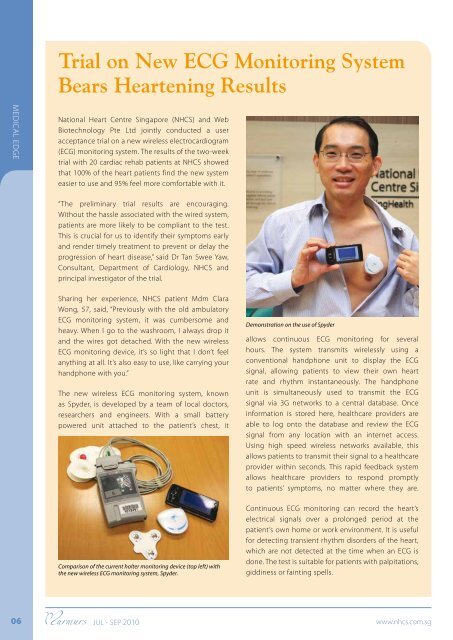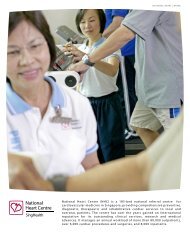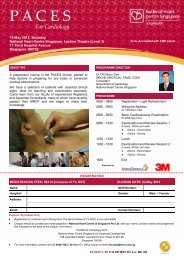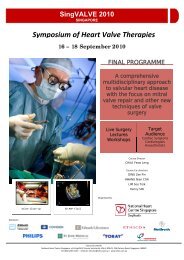Murmurs - National Heart Centre Singapore
Murmurs - National Heart Centre Singapore
Murmurs - National Heart Centre Singapore
You also want an ePaper? Increase the reach of your titles
YUMPU automatically turns print PDFs into web optimized ePapers that Google loves.
Trial on New ECG Monitoring System<br />
Bears <strong>Heart</strong>ening Results<br />
medical edge<br />
<strong>National</strong> <strong>Heart</strong> <strong>Centre</strong> <strong>Singapore</strong> (NHCS) and Web<br />
Biotechnology Pte Ltd jointly conducted a user<br />
acceptance trial on a new wireless electrocardiogram<br />
(ECG) monitoring system. The results of the two-week<br />
trial with 20 cardiac rehab patients at NHCS showed<br />
that 100% of the heart patients find the new system<br />
easier to use and 95% feel more comfortable with it.<br />
“The preliminary trial results are encouraging.<br />
Without the hassle associated with the wired system,<br />
patients are more likely to be compliant to the test.<br />
This is crucial for us to identify their symptoms early<br />
and render timely treatment to prevent or delay the<br />
progression of heart disease,” said Dr Tan Swee Yaw,<br />
Consultant, Department of Cardiology, NHCS and<br />
principal investigator of the trial.<br />
Sharing her experience, NHCS patient Mdm Clara<br />
Wong, 57, said, “Previously with the old ambulatory<br />
ECG monitoring system, it was cumbersome and<br />
heavy. When I go to the washroom, I always drop it<br />
and the wires got detached. With the new wireless<br />
ECG monitoring device, it’s so light that I don’t feel<br />
anything at all. It’s also easy to use, like carrying your<br />
handphone with you.”<br />
The new wireless ECG monitoring system, known<br />
as Spyder, is developed by a team of local doctors,<br />
researchers and engineers. With a small battery<br />
powered unit attached to the patient’s chest, it<br />
Comparison of the current holter monitoring device (top left) with<br />
the new wireless ECG monitoring system, Spyder.<br />
Demonstration on the use of Spyder<br />
allows continuous ECG monitoring for several<br />
hours. The system transmits wirelessly using a<br />
conventional handphone unit to display the ECG<br />
signal, allowing patients to view their own heart<br />
rate and rhythm instantaneously. The handphone<br />
unit is simultaneously used to transmit the ECG<br />
signal via 3G networks to a central database. Once<br />
information is stored here, healthcare providers are<br />
able to log onto the database and review the ECG<br />
signal from any location with an internet access.<br />
Using high speed wireless networks available, this<br />
allows patients to transmit their signal to a healthcare<br />
provider within seconds. This rapid feedback system<br />
allows healthcare providers to respond promptly<br />
to patients’ symptoms, no matter where they are.<br />
Continuous ECG monitoring can record the heart’s<br />
electrical signals over a prolonged period at the<br />
patient’s own home or work environment. It is useful<br />
for detecting transient rhythm disorders of the heart,<br />
which are not detected at the time when an ECG is<br />
done. The test is suitable for patients with palpitations,<br />
giddiness or fainting spells.<br />
06 www.nhcs.com.sg<br />
Jul - Sep 2010

















